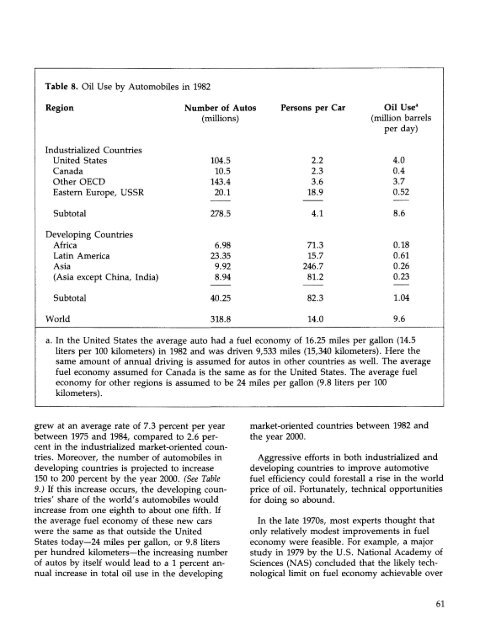ENERGY FOR A SUSTAINABLE WORLD - World Resources Institute
ENERGY FOR A SUSTAINABLE WORLD - World Resources Institute
ENERGY FOR A SUSTAINABLE WORLD - World Resources Institute
You also want an ePaper? Increase the reach of your titles
YUMPU automatically turns print PDFs into web optimized ePapers that Google loves.
Table 8. Oil Use by Automobiles in 1982<br />
Region<br />
Number of Autos<br />
(millions)<br />
Persons per Car<br />
Oil Use a<br />
(million barrels<br />
per day)<br />
Industrialized Countries<br />
United States<br />
Canada<br />
Other OECD<br />
Eastern Europe, USSR<br />
104.5<br />
10.5<br />
143.4<br />
20.1<br />
2.2<br />
2.3<br />
3.6<br />
18.9<br />
4.0<br />
0.4<br />
3.7<br />
0.52<br />
Subtotal<br />
278.5<br />
4.1<br />
8.6<br />
Developing Countries<br />
Africa<br />
Latin America<br />
Asia<br />
(Asia except China, India)<br />
6.98<br />
23.35<br />
9.92<br />
8.94<br />
71.3<br />
15.7<br />
246.7<br />
81.2<br />
0.18<br />
0.61<br />
0.26<br />
0.23<br />
Subtotal<br />
40.25<br />
82.3<br />
1.04<br />
<strong>World</strong><br />
318.8<br />
14.0<br />
9.6<br />
a. In the United States the average auto had a fuel economy of 16.25 miles per gallon (14.5<br />
liters per 100 kilometers) in 1982 and was driven 9,533 miles (15,340 kilometers). Here the<br />
same amount of annual driving is assumed for autos in other countries as well. The average<br />
fuel economy assumed for Canada is the same as for the United States. The average fuel<br />
economy for other regions is assumed to be 24 miles per gallon (9.8 liters per 100<br />
kilometers).<br />
grew at an average rate of 7.3 percent per year<br />
between 1975 and 1984, compared to 2.6 percent<br />
in the industrialized market-oriented countries.<br />
Moreover, the number of automobiles in<br />
developing countries is projected to increase<br />
150 to 200 percent by the year 2000. (See Table<br />
9.) It this increase occurs, the developing countries'<br />
share of the world's automobiles would<br />
increase from one eighth to about one fifth. If<br />
the average fuel economy of these new cars<br />
were the same as that outside the United<br />
States today—24 miles per gallon, or 9.8 liters<br />
per hundred kilometers—the increasing number<br />
of autos by itself would lead to a 1 percent annual<br />
increase in total oil use in the developing<br />
market-oriented countries between 1982 and<br />
the year 2000.<br />
Aggressive efforts in both industrialized and<br />
developing countries to improve automotive<br />
fuel efficiency could forestall a rise in the world<br />
price of oil. Fortunately, technical opportunities<br />
for doing so abound.<br />
In the late 1970s, most experts thought that<br />
only relatively modest improvements in fuel<br />
economy were feasible. For example, a major<br />
study in 1979 by the U.S. National Academy of<br />
Sciences (NAS) concluded that the likely technological<br />
limit on fuel economy achievable over<br />
61

















